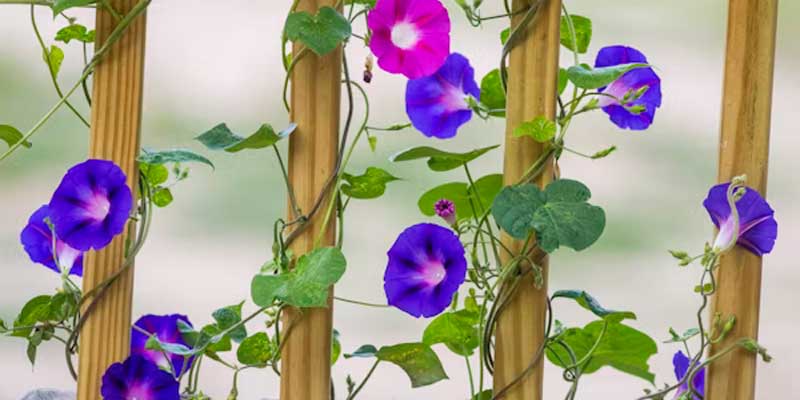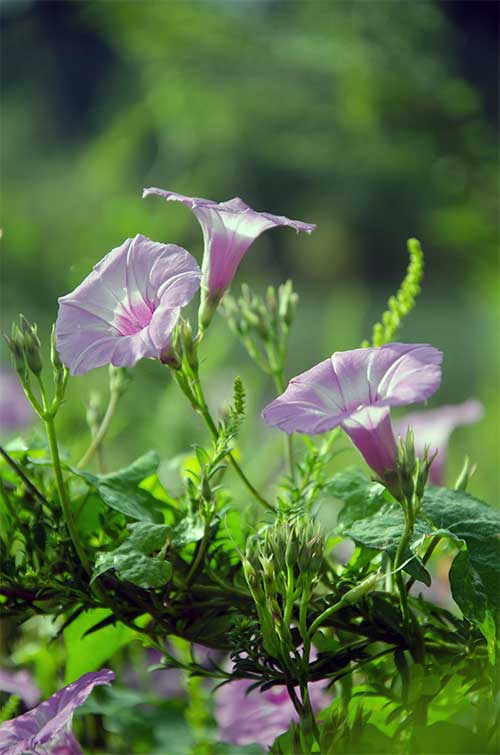Morning blooms–their ethereal beauty and ephemeral presence evoke wonder; they instill tranquility in gardens and natural landscapes. Gardeners, along with nature enthusiasts alike, hold a special place for these delicate flowers often associated with the dawn of a new day. But when—exactly—do morning blooms unfurl their petals: when precisely do they reveal their splendor? To maximize our experience of morning blooms’ enchantment, we must comprehend the precise timing at which they unfurl.
This article launches an expedition into the mesmerizing realm of these flowers: probing factors that shape their blooming schedules and shedding light on instances when you can observe them in full bloom, which is a truly captivating sight.
When Does Morning Glory Bloom?
The name “morning glory” accurately captures the typical behavior of these flowers: they bloom in the early morning hours, a burst of color and beauty to gardens and landscapes; this blooming period starts in late spring or early summer, extending through the summer months.
Sensitives to sunlight and temperature, these vibrant blooms open as an enthusiastic response to the sun’s warmth, yet paradoxically close with each advancing step of daylight progression. By diligently providing the necessary care and attention, gardeners can relish in summer’s enchantment as morning glory vines bloom.
4 Factors Influencing Morning Bloom Timing
The timing of morning blooms hinges upon several factors; these include environmental conditions, species characteristics, and physiological processes.
1. Photoperiod
The photoperiod – the length of daylight hours – crucially regulates the flowering time for various plant species, morning blooms included. Certain flowers innately sense changes in day length; as spring and summer usher in increasing daylight hours, this triggers their bloom initiation.
2. Temperature
Temperature fluctuations, both diurnal (daily) and seasonal, influence the timing of flower opening in many plant species. Particularly for those adapted to temperate climates, rapid petal expansion, and bloom unfurling can be promoted by cool nighttime temperatures followed by mild-to-warm daytime conditions.
3. Humidity and Moisture
These are the essential contributors to optimal flower development in many plant species. Moist soil by providing vital hydration to roots, facilitates water and nutrient transport towards developing flowers; thus, promoting blooming.
Moderate humidity levels additionally prevent excessive water loss from flower tissues, thus maintaining turgidity and averting wilting.
4. Genetic Factors
The flowering time and blooming schedule of a plant species or cultivar undergo influence by its genetic makeup. Certain species have evolved synchronous bloom patterns with particular environmental cu.es; however, others due to genetic variation within populations display variability in their flowering patterns.
The Blooming Schedule of Morning Flowers
Species characteristics, environmental conditions, and geographic location – these factors diversely influence the blooming schedules of morning blooms.
Early Spring
Some species—like the ephemeral woodland wildflowers bloodroot (Sanguinaria canadensis) and spring beauty (Claytonia virginica.)—open their delicate flowers during the early morning hours; thus, they signal spring’s imminent arrival. These charming blooms carpet forest floors with a fleeting yet captivating beauty.
Late Spring to Early Summer
As spring transitions towards early summer, species like the morning glory (Ipomoea purpurea), California poppy (Eschscholzia californica), and daylily (Hemerocallis spp.) adorn gardens, meadows, and natural landscapes with their radiant colors and delicate forms. In the early morning sunlight, flowers unfurl their petals to attract pollinators and mesmerize observers with their enchanting blooms.
Throughout the summer months, many morning blooms such as Mirabilis jalapa (the four o’clock flower), Gazania rigens (gazania), and Helianthus annuus (sunflower) open their colorful petals in a daily ritual. They offer an enticing respite from the heat of day to pollinators, inviting them with promises of nectar rewards.
Late Summer to Fall
The black-eyed Susan (Rudbeckia hirta), morning glory vine (Ipomoea spp. ), and other species of morning blooms prolong their flowering period; they offer a final burst of color before autumn arrives.
As the seasons transition, Marigold (Tagetes erecta) and Mexican Sunflower (Tithonia diversifolia) bloom in the early morning hours; they add vibrancy to gardens and landscapes.
5 Tips For Caring for Morning Blooms
Consider these tips for caring for morning blooms, which will ensure optimal blooming and vibrant flower displays:
1. Sunlight
Morning blooms flourish in locations abundant with sunlight exposure; therefore, allocate planting space for them in areas that secure a minimum of six hours daily under direct sun rays.
2. Watering
Ensure the roots of morning-blooming plants receive consistent moisture; it is vital to maintain soil that remains evenly moist. However, caution must be exercised not to waterlog it. To minimize water loss through evaporation and mitigate fungal disease risks, conduct this task early in the morning.
3. Fertilization
Apply a balanced fertilizer, specifically formulated for flowering plants, to provide essential nutrients; this promotes healthy growth and yields abundant blooms.
Ensure you adhere to the application rates and frequency advised by the manufacturer: these guidelines are crucial for optimal results in fertilization.
4. Deadheading
Regularly remove spent flowers to stimulate continuous blooming and circumvent the formation of seed heads; these divert energy from flower production.
5. Mulching
Apply a layer of organic mulch around the base of morning bloom plants; this action conserves soil moisture, suppresses weed growth, and regulates soil temperature: it’s an essential process known as mulching.
Conclusion
Morning glory blooms with its exquisite beauty, delicate fragrance, and ephemeral presence, which enrich our lives since they serve as a reminder of the inherent wonder in the natural world. Gardeners who understand the factors influencing these flowers’ blooming schedule can cultivate vibrant displays by providing proper care; thus not only delighting the senses but also inspiring imagination through nature’s poetry.
Adorning gardens, meadows, or wild landscapes: morning blooms captivate observers with an enchanting allure. They invite us to pause to appreciate and savor each fleeting moment of floral splendor that graces a new day.



Leave a Reply